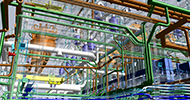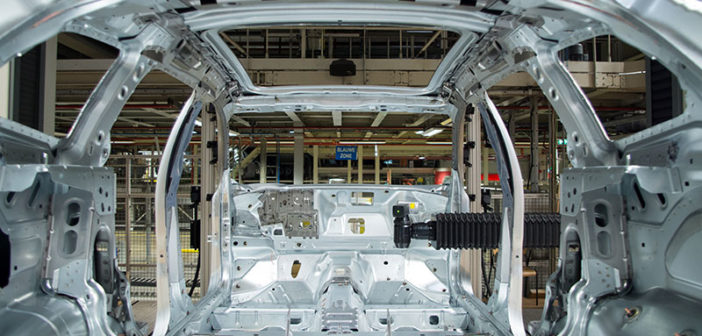Like their counterparts around the world, automotive manufacturers here in Canada are noticing new trends emerging as the industry continues to grow. Like all opportunities, the growth comes hand in hand with new challenges that need to be surmounted. Keeping pace, and staying ahead of the curve is one of the issues automotive manufacturers face. With this in mind, manufacturers are seeking new solutions to remain competitive in the industry.
As one of the top ten automotive producers in the world, Canadian car manufacturers must continuously evolve their production processes to remain competitive. As the demand for parts continues to increase, automotive Original Equipment Manufacturers (OEMs) and Tier manufacturers are looking for new and innovative ways to increase their productivity at the point of manufacturing. One trend we are beginning to see in Canada is traditional check fixture de-contenting. Fixture de-contenting involves removing unnecessary fixtures, allowing you to have better access to the features and characteristics of a part.
Changing strategies from an R1 or full cut back fixture to one with independent nets, clamps and locators represents not only a cost-saving opportunity, but enables access for scanning systems to measure the part. Free state measurement during launch phase is critical for part development. This can be easily performed if the part is rigid within itself, otherwise you are using your fixture or tool to hold the part. Scanning throughout the product development stage gives production visibility to the changes and progress being made at each point in the production cycle. This is often represented by dimensional color mapping of the parts. Equipment such as 3D optical scanning systems and portable measuring arms like Hexagon Manufacturing Intelligence’s BLAZE 600M and ROMER Absolute Arm offer the most benefit. This holding fixture strategy is not only an asset during product development and launch phase. The fixtures can also be used during production within an automated scanning cell such as the 360º Flexible Measurement Cell (FMC) configuration available in North America, where speed and flexibility is key.
The Age of Automation
Automation isn’t a new concept, yet many manufacturers are just starting to adapt it to their process. When one hears the term automation they immediately think of a robot welding, or placing a part in a fixture or some other repetitive application. But automation within production offers much more to those who embrace the technology. Manufacturers are finding that the flexibility to measure multiple parts at the line, with program capabilities that allow both trending and the ability to provide data sets that reveal root cause capabilities, is a benefit to the overall improvement of their manufacturing process.
Process improvement begins when manufactures look at their current production holistically, instead of each individual phase. By looking at how quality can become affected at each stage of the manufacturing process, and making smart adjustments to their production, automotive suppliers can effectively improve their production workflow.
Automation Drivers
While manufacturers understand the need to improve their production process, many are still faced with process improvement challenges. One of these challenges includes understanding where to begin with automating their process. With Lights Out Manufacturing as a goal, understanding how evolving trends like Industry 4.0 or the digital thread have an impact on production workflow may seem daunting. Furthermore, the challenge of a shrinking skilled labor force adds even more pressure for manufacturing workflow to change.
How does an advanced manufacturer keep pace?
Savvy manufacturers look towards solutions that will prepare them for the future. To do this, companies need to take a holistic view of their process to find areas of improvement. Hexagon is here to help these businesses address some of these challenges from the beginning, middle, and end of the manufacturing lifecycle.
Quality at The Design Stage
Automation begins at the design stage. Embedding the manufacturing process in CAD defines your process strategy. Segmented processes of design, passed through the cutter path, to a machining center, to an inspector leads to many gaps for errors and stack ups. Automating these processes using embedded geometric dimensioning and tolerancing (GD&T) in CAD allows you to streamline the machining by accessing libraries of cutting tools to optimize the cutter path. By utilizing Model Based Engineering (MBE) to embed items like GD&T, component level materials, assembly level bills of materials, engineering configurations and design intent into the CAD starts to define your process strategy.
Quality at The Point of production
PC-DMIS can automatically generate measurement paths by applying this same strategy. This applies to tooling, machined components or even final parts. To take it a step further, PC-DMIS NC enables you to validate your product on the machining center itself. Within the production process, Hexagon’s shop-floor CMMs like the TIGO SF, 4.5.4 SF, and 7.10.7 SF enable you to truly begin to measure at the point of manufacturing. These systems have the durability required to go shoulder to shoulder with machining centers, offering at-machine validation. Hexagon’s Q-DAS software ties the CMM and CNC together by directing the CNC to make adjustments based on CMM data. With this information, processes like direct cutter compensation (due to tool wear) allows users to maximize their tool life. With processes like these in place, production can proceed seamlessly with limited human interaction required.
Future of Quality production
Emerging trends in software like Industry 4.0 and the digital thread rely heavily on actionable data. Hexagon’s recent technology enhancements such as the PULSE environmental monitoring system, or HxGN SMART Quality, the online quality data and measurement resource management software, allow manufacturers to receive data and be able to make decisions based on that data faster than ever before. Data from software packages such as these can keep quality managers informed on the utilization of their machines, inspection tools and the conditions in which the machines are performing.
The challenges faced today by Canadian manufacturers are not limited to maintaining competitiveness in a global market. Identifying, investing, and executing process improvements which are future ready allow manufacturers to advance their workflows and remain competitive 5, 10, 15 years down the road.














